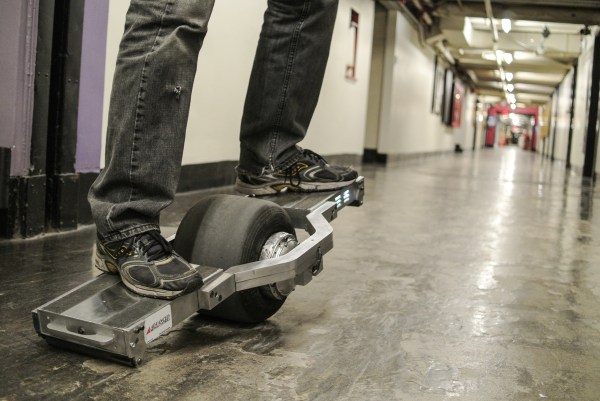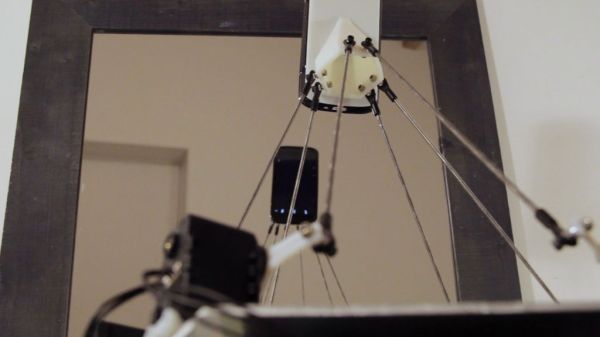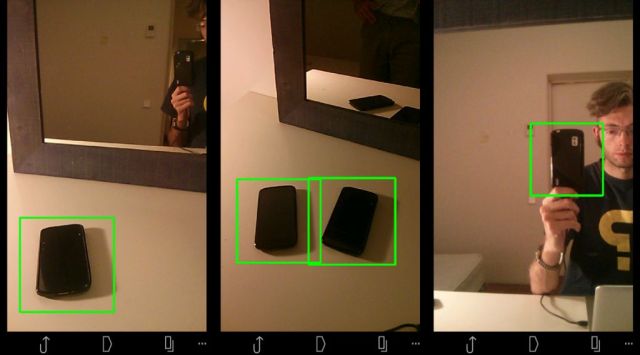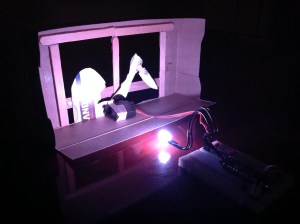When functional engineering blends itself with design and aesthetics, the things we encounter in daily life make the world a more exciting place to be. Artist, [Daan Roosegaarde’s] solar-powered walkway was unveiled last night in Nuenen, Netherlands, illuminating a kilometer long pathway with swirling light, transforming the space visually with functionality.
If the blue and green flowing spirals look familiar, that’s because they were inspired by the painting, Starry Night by Vincent Van Gogh, who was a resident of Nuenen for part of his life. The mosaic-like shapes arranged throughout the path are coated in a special paint containing a chemical that absorbs sun light in order to glow effectively for up to ten hours over night.
 This project is the second installment of [Studio Roosegaarde’s] Smart Highways Research; the larger goal of which is to integrate new technology with roads in an artistically inspired approach to make commuting safer and more energy-efficient. In a few other similar incentives, [Roosegaarde] envisions using this same glowing paint for road markings as a means to help replace the need for street lights. The paint coating he proposes would also be temperature sensitive and capable of creating images to indicate to drivers when there may be ice present due to freezing. His ideas for upgraded roads include a priority lane that could recharge electric cars by means of induction coils built-in underneath them. Even cooler yet, [Roosegaarde] has also proposed the possibility of engineering trees to contain the bioluminescent qualities of some jellyfish and mushrooms so that they too can help replace costly artificial light outdoors. Since some of these technologies are set to be implemented in parts of the Netherlands in the coming years, the re-envisioned environmentally aware future could very well look like a fantasy scene from a painting.
This project is the second installment of [Studio Roosegaarde’s] Smart Highways Research; the larger goal of which is to integrate new technology with roads in an artistically inspired approach to make commuting safer and more energy-efficient. In a few other similar incentives, [Roosegaarde] envisions using this same glowing paint for road markings as a means to help replace the need for street lights. The paint coating he proposes would also be temperature sensitive and capable of creating images to indicate to drivers when there may be ice present due to freezing. His ideas for upgraded roads include a priority lane that could recharge electric cars by means of induction coils built-in underneath them. Even cooler yet, [Roosegaarde] has also proposed the possibility of engineering trees to contain the bioluminescent qualities of some jellyfish and mushrooms so that they too can help replace costly artificial light outdoors. Since some of these technologies are set to be implemented in parts of the Netherlands in the coming years, the re-envisioned environmentally aware future could very well look like a fantasy scene from a painting.
Continue reading “Starry Walkway In The Netherlands Lights Up The Night”




 Hardware-wise, the #selfie bot is a Stewart platform made from six servo motors and a few pieces of carefully measured pushrod connected with swivel-ball-links. An android phone is mounted on the end effector which acts functionally as the robot’s face and eyes. To make it self-aware in a sense, [Ajna] and [Hersan] created their own recognition software with Open CV using a collection of sample images of various phones as reference points. As soon as the robot recognizes itself in the mirror as indicated by specific words flashing on its screen, it takes a picture, immediately uploading it to its own
Hardware-wise, the #selfie bot is a Stewart platform made from six servo motors and a few pieces of carefully measured pushrod connected with swivel-ball-links. An android phone is mounted on the end effector which acts functionally as the robot’s face and eyes. To make it self-aware in a sense, [Ajna] and [Hersan] created their own recognition software with Open CV using a collection of sample images of various phones as reference points. As soon as the robot recognizes itself in the mirror as indicated by specific words flashing on its screen, it takes a picture, immediately uploading it to its own 
 The device is little more than the internet and a speaker stuffed into a minimal black cylinder the size of a vase, oh- and six far-field microphones aimed in each direction which listen to every word you say… always. As you’d expect, Echo only processes what you say after you call it to attention by speaking its given name. If you happen to be too far away for the directional microphones to hear, you can alternatively seek assistance from the Echo app on another device. Not bad for the freakishly low price Amazons asking, which is $100 for Prime subscribers. Even if you’re salivating over the idea of this chatting obelisk, or intrigued enough to buy one just to check it out (and pop its little seams), they’re only available to purchase through invite at the moment… the likes of which are said to go out in a few weeks.
The device is little more than the internet and a speaker stuffed into a minimal black cylinder the size of a vase, oh- and six far-field microphones aimed in each direction which listen to every word you say… always. As you’d expect, Echo only processes what you say after you call it to attention by speaking its given name. If you happen to be too far away for the directional microphones to hear, you can alternatively seek assistance from the Echo app on another device. Not bad for the freakishly low price Amazons asking, which is $100 for Prime subscribers. Even if you’re salivating over the idea of this chatting obelisk, or intrigued enough to buy one just to check it out (and pop its little seams), they’re only available to purchase through invite at the moment… the likes of which are said to go out in a few weeks.


 Impatient Severed Fingers – [Amanda] came up with a cute use for some mini servos and a zombie hand prop. The five severed fingers were attached to one end of a plastic rod. The other end was mounted to each of five servos which were laid out in the appropriate hand shape and attached to a fixed base. An Arduino running a basic sweep sketch animated the motors at slightly staggered intervals, creating a nice rolling effect. Even with the moving parts exposed this prop would be awesome to have on display, or set the ambiance with its continuous tapping…
Impatient Severed Fingers – [Amanda] came up with a cute use for some mini servos and a zombie hand prop. The five severed fingers were attached to one end of a plastic rod. The other end was mounted to each of five servos which were laid out in the appropriate hand shape and attached to a fixed base. An Arduino running a basic sweep sketch animated the motors at slightly staggered intervals, creating a nice rolling effect. Even with the moving parts exposed this prop would be awesome to have on display, or set the ambiance with its continuous tapping… Angry Spectral Delta – [Nathan Bryant] made an actual costume for his delta robot from Robot Army. By attaching a small plastic skull to the end effector and draping a tattered piece of fabric over the rest of the mechanism he effectively transformed the delta into a little ghost with a sassy personality. The head swiftly bobbed about, all while staying parallel to the table… until it intermittently came unhinged and hung limply, which was a nice added effect!
Angry Spectral Delta – [Nathan Bryant] made an actual costume for his delta robot from Robot Army. By attaching a small plastic skull to the end effector and draping a tattered piece of fabric over the rest of the mechanism he effectively transformed the delta into a little ghost with a sassy personality. The head swiftly bobbed about, all while staying parallel to the table… until it intermittently came unhinged and hung limply, which was a nice added effect! Robotic Exorcism Baby – This doll could turn its half skeleton, half baby face 180 degrees and then laugh at your fear. By attaching two servo motors together, [Jeremy] was able to create a pan and tilt mechanism which acted as the baby’s contorting neck and chattering jaw. The micro controller sending commands to the motors was hidden modestly under her dress.
Robotic Exorcism Baby – This doll could turn its half skeleton, half baby face 180 degrees and then laugh at your fear. By attaching two servo motors together, [Jeremy] was able to create a pan and tilt mechanism which acted as the baby’s contorting neck and chattering jaw. The micro controller sending commands to the motors was hidden modestly under her dress. Stabby Animated Cardboard Shadowbox – Among the animatronic devices seen at the event was a shadowbox made by [Brandon] hidden in a dark conference room nearby. When one happened to walk past the seemingly unoccupied space, they’d glimpse the silhouette of an arm stabbing downward with a knife through a windowsill. Being lured in for further investigation you’d find that the shadow was being cast by some colored LEDs through a charmingly simple device. A cutout made from recycled card stock was attached to a single servo. This whole mechanism itself rocked back and forth slightly as the motor moved, which wasn’t intentional but added some realism to the motion of the stabby arm.
Stabby Animated Cardboard Shadowbox – Among the animatronic devices seen at the event was a shadowbox made by [Brandon] hidden in a dark conference room nearby. When one happened to walk past the seemingly unoccupied space, they’d glimpse the silhouette of an arm stabbing downward with a knife through a windowsill. Being lured in for further investigation you’d find that the shadow was being cast by some colored LEDs through a charmingly simple device. A cutout made from recycled card stock was attached to a single servo. This whole mechanism itself rocked back and forth slightly as the motor moved, which wasn’t intentional but added some realism to the motion of the stabby arm.








